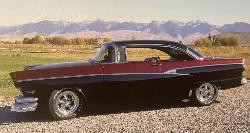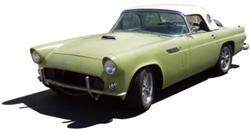|
Author
|
Message
|
|
John Didde
|
|
|
Group: Forum Members
Last Active: 7 Years Ago
Posts: 37,
Visits: 426
|
My 56 merc 312, i have a mopar long reach thermostat drilled 3 ea 3/16 holes in thermostat, plug bypass and drilled 1 ea 5/16 in by pass, works great, only problem at idle it will heat up a little at idle increase the speed of the a little and temp drops to previous temp , so i am installing a 5 inch pulley and 6 blade fan. the set up is working fine i am happy with setup
|
|
|
|
|
Rono
|
|
|
Group: Forum Members
Last Active: Last Year
Posts: 1.3K,
Visits: 80.0K
|
Thanks guys for your input. I tested my 160 degree T stat and it opens as it should. I think I will pass for now on modifying it, because it is not the same design as the one pictured. 160 works for me here in the summer at the edge of the desert in Idaho. Also, Mr. Gasket no longer makes the high flow thermostats. I checked on this at a distribution center for all the parts houses and that's what I was told.
 Ron Lane, Meridian, ID Ron Lane, Meridian, ID
|
|
|
|
|
charliemccraney
|
|
|
Group: Moderators
Last Active: Yesterday
Posts: 6.1K,
Visits: 442.8K
|
Restricting or blocking the bypass in not something that was invented by the Y-Block community. Stewart Components, a manufacturer of cooling system components is one manufacturer who does this and recommends it in some situations. You can read through their tech tips section. http://www.stewartcomponents.com/index.php?route=information/information&information_id=6It might go against convention, but there are good reasons to do it. Like any modification, it is important that the person carrying it out understands the pros and cons and performs the modification correctly if it is decided that it will be beneficial. If that is done, then there will be no problems.
Lawrenceville, GA
|
|
|
|
|
GREENBIRD56
|
|
|
Group: Forum Members
Last Active: Last Year
Posts: 1.7K,
Visits: 102.7K
|
The area of the bypass port is about .150 inches² - and the area of the three 3/16 holes is .083 inches² - so about 50% of original. Neither would be capable accepting full flow of the pump, so basically the impeller spins in the water ....... regardless. When the thermostat is closed, its similar to running a drill drive paint agitator - but not the kind of "CAVITATION" that engineers talk about. When running with the modified system in the mode where the t-stat is closed and it is bleeding water through the three holes - the water entering the heads is coming up from the block and lower end of the radiator. So the thermal effects are going to be different from simply recycling hot water as the fluid has more heat absorbing capacity.

Steve Metzger Tucson, Arizona
|
|
|
|
|
miker
|
|
|
Group: Forum Members
Last Active: Last Month
Posts: 1.9K,
Visits: 194.9K
|
I had an off topic engine that did the same cycling on warm up. Aluminum heads with the temp sensor in the heads near the exhaust.
Showed over temp, then a drop, then overtemp, and finally settled down. I changed the stat, drilled holes, etc. Finally on day I noticed that if I turned the heater on it didn't happen. I installed a small #6AN bypass hose between the hot side of the intake to the water pump suction side. Problem gone. So at least some engines, when modified with the aluminum heads, needed the bypass when the stock ones with iron heads didn't.
On my bird, with the water pump spacer, I think the impeller is so inefficient at idle that cavitation from a restricted bypass isn't a problem. But with a good radiator/fan/shroud combo, I'm good at idle at 90 degrees.
miker
55 bird, 32 cabrio F code
Kent, WA
Tucson, AZ
|
|
|
|
|
2721955meteor
|
|
|
Group: Forum Members
Last Active: Last Year
Posts: 927,
Visits: 190.0K
|
the bypass keeps water circulating when stat closed,as it opens there is a transition to the rad. when stat open 99% os the water goes out stat threw upper hose and the water pump wont capitate threw the transition.
ypass.most over heating is things other than the bypass.
if therms wher to have holes i think they would be there. i sugest reading the principals of radiator cooling systems,cause and remedeys for over heating. race car guyes usually rebuild the engine frequently. unlike collector cars etc
|
|
|
|
|
Gene Purser
|
|
|
Group: Forum Members
Last Active: 4 Years Ago
Posts: 220,
Visits: 6.0K
|
Thanks Greenbird, I couldn't make up my mind if the 5/8" hose port on the water pump was pressure or suction. I see warnings against blocking the bypass. I have a 3/16" hole in a plug blocking the bypass and three holes drilled into the outer ring of the thermostat. Do you think I'm on solid ground?
Thanks again for the detailed explanation
Gene
|
|
|
|
|
GREENBIRD56
|
|
|
Group: Forum Members
Last Active: Last Year
Posts: 1.7K,
Visits: 102.7K
|
Gene - Water exits the block through the neck on the front of the intake manifold. The neck contains the t-stat - and below it a bypass port that fits into a 5/8 hose. That short hose directs water back into the suction side of the water pump. When the engine starts up cold, the t-stat is closed and all of the pump output is directed to exit through the bypass port - most likely causes an impeller inefficiency (designed in CAVITATION?) due to the restriction. Heated water leaving the heads into the intake (moving to the bypass port) gradually warms the t-stat and causes it to open. Once the thermostat opens and begins to regulate - it maintains temperature control by speeding or slowing water that is exiting the block - headed into the radiator. A portion of the water is always bypassing the radiator (even if you are up near boiling) - and is being recycled into the block with no loss of temperature. This volume of water is what the modification is intended to redirect into the radiator. When the modified t-stat is in place and water is restricted at the bypass port - water leaving the heads at start-up exits through the drilled thermostat. Modified as shown above - the heated water goes directly over the operational "pill" of the t-stat, and it begins regulate temperature by controlling the exit. No hot water (or very little) is sent directly back into the block. More - or larger holes may be possible if a different t-stat is used - but it could be set-up to have nearly the same restriction as the factory port.

Steve Metzger Tucson, Arizona
|
|
|
|
|
Gene Purser
|
|
|
Group: Forum Members
Last Active: 4 Years Ago
Posts: 220,
Visits: 6.0K
|
'Scuse my ignorance here, but does the bypass water flow toward the thermostat/intake manifold, or toward the water pump?
|
|
|
|
|
GREENBIRD56
|
|
|
Group: Forum Members
Last Active: Last Year
Posts: 1.7K,
Visits: 102.7K
|
I think the 3 x 3/16 holes in the T-stat have always been part of blocking off the bypass - some may not have read the whole discussion in past threads. Water has to migrate toward the t-stat to facilitate proper opening as the heads heat the top end of the engine. Try holding water in a bottle that has three such holes in it and you'll get an idea of the flow volume - though within our engines, an impeller is also pumping toward the opening. If flow is stalled by complete blockage - the temp spike would be an obvious indication of no water movement.

Steve Metzger Tucson, Arizona
|
|
|
|